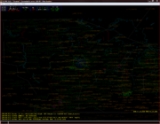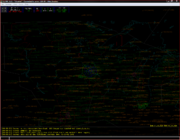
Virtual Radar Client
Encyclopedia
Virtual Radar Client (VRC) is a Windows
-based software application that simulates the radar
workstations of real-world air traffic control
lers. It allows the user to simulate the duties of Air Traffic Controllers by viewing a radar display of, and data pertaining to virtual aircraft connected to the VATSIM network of air traffic and flight simulation.

. VRC was created with multi-monitor users in mind, with all non-essential data being displayed in windows that can be moved to the second screen. It is one of three major radar clients, its rivals being ASRC and Euroscope.
VRC is not available for Macintosh
or Linux
based users, nor is ever planned to be. Some clients have reported being able to run VRC using Windows compatibility layers, such as Wine
and BootCamp. VRC is proprietary and closed-source software, but it is free.

Microsoft Windows
Microsoft Windows is a series of operating systems produced by Microsoft.Microsoft introduced an operating environment named Windows on November 20, 1985 as an add-on to MS-DOS in response to the growing interest in graphical user interfaces . Microsoft Windows came to dominate the world's personal...
-based software application that simulates the radar
Radar
Radar is an object-detection system which uses radio waves to determine the range, altitude, direction, or speed of objects. It can be used to detect aircraft, ships, spacecraft, guided missiles, motor vehicles, weather formations, and terrain. The radar dish or antenna transmits pulses of radio...
workstations of real-world air traffic control
Air traffic control
Air traffic control is a service provided by ground-based controllers who direct aircraft on the ground and in the air. The primary purpose of ATC systems worldwide is to separate aircraft to prevent collisions, to organize and expedite the flow of traffic, and to provide information and other...
lers. It allows the user to simulate the duties of Air Traffic Controllers by viewing a radar display of, and data pertaining to virtual aircraft connected to the VATSIM network of air traffic and flight simulation.

Description
VRC is a program designed to emulate a radar screen used by Air Traffic Controllers. It was created by Ross Carlson, and released by VATSIM to the flying public Friday, April 14, 2006. VRC sends and receives data in real time to the VATSIM servers which allows users to provide the functions of ATCATC
- Military :* Air Training Command, the predecessor to Air Education and Training Command in the United States Air Force* New Zealand Air Training Corps* Air Training Corps, United Kingdom...
. VRC was created with multi-monitor users in mind, with all non-essential data being displayed in windows that can be moved to the second screen. It is one of three major radar clients, its rivals being ASRC and Euroscope.
VRC is not available for Macintosh
Macintosh
The Macintosh , or Mac, is a series of several lines of personal computers designed, developed, and marketed by Apple Inc. The first Macintosh was introduced by Apple's then-chairman Steve Jobs on January 24, 1984; it was the first commercially successful personal computer to feature a mouse and a...
or Linux
Linux
Linux is a Unix-like computer operating system assembled under the model of free and open source software development and distribution. The defining component of any Linux system is the Linux kernel, an operating system kernel first released October 5, 1991 by Linus Torvalds...
based users, nor is ever planned to be. Some clients have reported being able to run VRC using Windows compatibility layers, such as Wine
Wine
Wine is an alcoholic beverage, made of fermented fruit juice, usually from grapes. The natural chemical balance of grapes lets them ferment without the addition of sugars, acids, enzymes, or other nutrients. Grape wine is produced by fermenting crushed grapes using various types of yeast. Yeast...
and BootCamp. VRC is proprietary and closed-source software, but it is free.
Radar Modes
| Radar Mode | Common Position Utilised On | Description |
|---|---|---|
| Simple | Clearance Delivery | Contains only the aircraft's callsign and voice capabilities |
| Ground | Ground Movement Control | Contains aircraft's callsign, aircraft type, ground speed and voice capabilities. |
| Tower | Tower Control | Targets contain a full data block, with all of the above plus warnings when aircraft are, for example, squawking an incorrect ASSR Code. |
| ARTS | Approach Control | Designed to mimic the American Terminal Control Center Terminal Control Center A terminal radar approach control is an air traffic control facility usually located within the vicinity of a large airport. Typically, the TRACON controls aircraft within a 20-50 nautical mile radius of the major airport and a number of "satellite airports" between surface and up to between and... setup, targets will contain varying amounts of data depending on the squawk mode of the aircraft, amongst other things. |
| STARS | Approach Control | Similar to ARTS mode, however the target's data tag rotates at a slower rate. |
| DSR | Enroute Control | This mode is similar to what would be found in a standard Area Control Centre. It contains up to three lines of information in the data tag including destination, ground speed, temporary assigned altitudes and aircraft ownership. |
| Park Air | Approach Control | This mode is similar to the radar setup found in British Approach Control Units, and displays 2 lines of information when the aircraft is squawking mode Charlie, and nothing when squawking mode standby. |
| TAAATS | Approach Control | Designed to appear similar to a radar screen found in an Australian Terminal Control Center Terminal Control Center A terminal radar approach control is an air traffic control facility usually located within the vicinity of a large airport. Typically, the TRACON controls aircraft within a 20-50 nautical mile radius of the major airport and a number of "satellite airports" between surface and up to between and... . This mode's datatag contains 4 lines of information at some points with data such as wake vortex separation and Reduced Vertical Separation Minima Reduced Vertical Separation Minima Reduced Vertical Separation Minima or Minimum is an aviation term used to describe the reduction of the standard vertical separation required between aircraft flying above FL285 and up to FL410 from 2,000 feet to 1,000 feet... status. The style of the blip displayed also changes dependant on what code the aircraft is squawking. |
| PSR | Various | Simulates a Primary Surveillance Radar, hence displays only the aircraft's blip. |
| 3D | Ground, Tower Control | Simulates a basic 3D view from an air traffic control tower. The datatag contains one line of information which periodically cycles. |

See also
- Advanced Simulated Radar Client
- VATSIM
- Air Traffic ControlAir traffic controlAir traffic control is a service provided by ground-based controllers who direct aircraft on the ground and in the air. The primary purpose of ATC systems worldwide is to separate aircraft to prevent collisions, to organize and expedite the flow of traffic, and to provide information and other...
- Flight SimulatorFlight simulatorA flight simulator is a device that artificially re-creates aircraft flight and various aspects of the flight environment. This includes the equations that govern how aircraft fly, how they react to applications of their controls and other aircraft systems, and how they react to the external...

